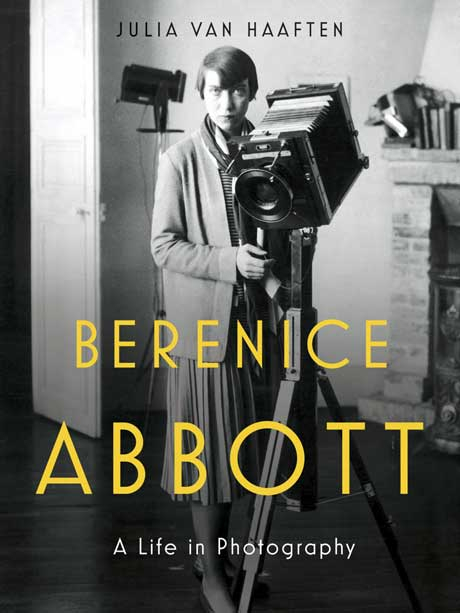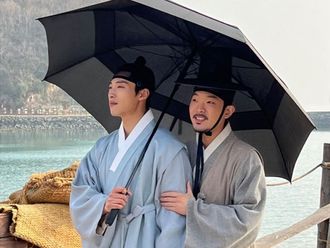By Julia Van Haaften, Illustrated, W.W. Norton & Co, 634 pages, $45
The photographer Berenice Abbott (1898-1991), daughter of a cement-maker, grew up poor in the Midwest and maintained an accent that one observer called “harsh Ohio”.
One of nature’s misfits, Abbott escaped to Ohio State University in 1917 and bobbed her hair. This was, she would comment, “my first ever act of rebellion.” After one year she dropped out and fled to Greenwich Village in New York City. She rarely set foot in Ohio again.
Abbott would become, in 1920s Paris, one of the world’s important portrait photographers, making sensitive and indelible images of everyone from Jean Cocteau and James Joyce to Janet Flanner and Djuna Barnes.
She returned to New York and, in just one stage of her long career, became a revolutionary chronicler of the modern metropolis. Her pulsing photograph Nightview, New York, taken from an upper-floor window of the Empire State Building in 1932, remains among the most widely recognised images we have of the city.
Working in the Bowery, Abbott made photographs like Blossom Restaurant, in which a handwritten menu sprawls like graffiti across a restaurant window in 1935. The poet Charles Simic has written that he could survive a long solitary confinement if he could study this photograph at leisure.
When a male supervisor told Abbott that “nice girls” don’t go to the Bowery, she replied: “Buddy, I’m not a nice girl. I’m a photographer ... I go anywhere.”
Abbott led a large, unconventional and sometimes wild life, and it’s astonishing — a better word might be maddening — that Julia Van Haaften’s Berenice Abbott: A Life in Photography is the first full-dress biography we have of her.
Van Haaften, who was the founding curator of the New York Public Library’s photography collection, wrestles Abbott’s big life onto the page. This is a vital work of American cultural history, and it wedges in so many personalities and vistas that it’s hard to know where to begin.
From the start, Abbott seemed more vivid than most people. She had big blue-green eyes — “enormous Kewpie eyes,” in the words of the impresario Lincoln Kirstein. The journalist Kay Larson called them “startling glacial turquoise.”
With her bobbed hair, no-nonsense mien and tendency to wear trousers — this at a time when doing so got a woman hassled on the street — Abbott was an eyeful. Throughout her life, photographers and painters competed to capture her image; Isamu Noguchi made a sculpture of her in 1929.
In Greenwich Village, when she was all of 20, Abbott fell in with a crowd that included playwright Eugene O’Neill (she had small parts in several productions of his plays), poet Edna St Vincent Millay, writer Malcolm Cowley and photographer Man Ray.
She did not have a trust fund, like some in her milieu. She worked as a waitress, a secretary and a reader for a clipping service. She wanted to study journalism but Columbia’s programme was too crowded for her taste, and then it closed during the First World War.
Abbott was a chain-smoker, a big drinker at times, and she liked to dance. She and Man Ray were kicked off one dance floor for “obscenity,” Van Haaften writes, which is one definition of pretty good dancing. When Man Ray needed a divorce, and the only ground New York state would accept was adultery, Abbott agreed to be named as the other woman.
Abbott began to slip an extra “e” into her birth name, which was Bernice. (She was upset when some publications, including the New York Times, omitted the extra letter.) She began to have relationships with women, and had several great early love affairs.
Abbott moved to Paris in 1921, when she was 22. She might as well be “poor there as poor here,” she thought. She became a portrait photographer after working as Man Ray’s studio assistant. Her friends in Paris included Andre Gide, the bookstore owner Sylvia Beach and Hadley Richardson, Ernest Hemingway’s first wife. Her fame was spread by Janet Flanner, who sometimes wrote about Abbott’s work in her “Letter From Paris” in The New Yorker. Joyce immortalised his portrait session with Abbott in “Finnegans Wake,” noting how “the Tulloch-Turnbull girl with her coldblood kodak shotted the as yet unremuneranded national apostate, who was cowardly gun and camera shy.”
In Paris, Abbott also befriended the then-elderly photographic pioneer Eugene Atget, and after his death she purchased his archive, which would become something of an albatross for her.
Back in New York, Abbott began making her famous city images and worked for the WPA’s Federal Art Project during the Depression. She took freelance work, including shooting titans of industry for Fortune magazine, which she generally loathed.
She entered into a three-decades long relationship with the Kansas-born journalist and critic Elizabeth McCausland. Van Haaften smuggles in piquant details about their lives. About their apartment on Commerce Street in the Village, for example, she writes: “With no shower or tub, they managed sponge baths in a small sink, with towels on the floor, for their entire 30-year tenancy.”
During the photographic boom of the 1970s, Abbott would be rediscovered and recognised for the genius she was. The money began to come in. But there were lean times in between. This book is a near-anthology of rejection, from grant committees, publishers and galleries.
Abbott could be tough to deal with, and frequently got into spats about things like ownership of negatives. “For somebody who might have been a terrific softy, I got pretty hard early,” she said.
For a period she took well-regarded scientific photographs before moving to Maine, buying a Jeep and essentially retiring. She still liked dancing with women. She wrote to a friend: “There has been some mighty friggin dancing going on. I’m not sure what friggin means but the word around here is legion.”
The last quarter of this book is primarily made up of the honours Abbott received, and is a slog that even Jackie Onassis flying up to see her on a private plane cannot redeem.
Van Haaften can’t help but type up every detail (“Berenice’s 90th birthday celebration included an afternoon excursion on the historic Moosehead Lake steamboat Katahdin”), so much so that you lose a bit of your goodwill towards the earlier portions of the book.
This is a less than perfect biography in other ways. The author is better on the trees than the forest, and as a writer she is sometimes flat-footed. The narrative has a tendency to skip around in time. But Van Haaften has done her research, the real work, and the pages turn themselves.
“Everybody writes, but they know they are not ‘writers’,” Abbott once said. “Everybody photographs, but they don’t realise they are not photographers.”
This book sends you back to Abbott’s images. Looking at them, you might recall Lewis Mumford’s line about one of Abbott’s early solo shows. Writing in The New Yorker, he said that he wanted “miles and miles of such pictures.”
–New York Times News Service










